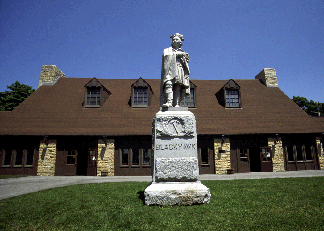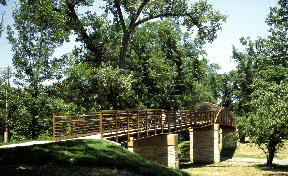1510 46th Avenue
Rock Island, IL 61201
309/788-0177
Open:
Mar-Oct: Wed-Sun 9 a.m. – 5 p.m.
Nov-Feb: Wed-Sun 9 a.m. – 4 p.m.
Closed noon to 1 p.m.
Teachers in Illinois schools (grades prekindergarten through 12) can apply for grant funds to visit this site on a field trip with their students. Click here for the details.

Black Hawk State Historic Site commemorates Native Americans of the area, particularly the Sauk and Mesquakie (Fox) Indians, who lived here from about 1750 to 1831. At the nearby site of Saukenuk, an estimated 4,800 Sauk in 1826 comprised one of the largest Native American cities in North America and what may have been the largest city—Native American or European American—in Illinois. In the late 1820s, however, Anglo-Americans began developing settlements and gradually forced the tribes across the Mississippi River. In 1832, fifteen hundred Sauk and Mesquakie, led by the warrior Black Hawk, returned to plant crops, precipitating a fifteen-week conflict known as the Black Hawk War. Their defeat marked the passing of Native Americans from Illinois.
The Watch Tower Lodge, built between 1934 and 1942 by the Civilian Conservation Corps and the State of Illinois, is a one-story limestone structure with rough-hewn timber construction. The large main room has vaulted ceilings supported by cedar timbers and two floor-to-ceiling stone fireplaces. Two Works Progress Administration murals have been restored by the state, and basement “nature rooms” are available for science activities with school groups. Exhibits in the John Hauberg Museum of Native American Life depict the daily life of the Sauk and Mesquakie Indian nations. Dioramas show the four seasons with a full-sized winter house, a replica of a summer long house, an authentic dugout canoe, and other objects relating to the Sauk and Mesquakie. Another exhibit describes the importance of the fur trade to the Native Americans. Also located in the Lodge is an exhibit outlining the 1934-1942 activities of the Civilian Conservation Corps in developing Black Hawk Park. Watch Tower Lodge is accessible to persons with disabilities. Outside the lodge is a large statue of Black Hawk (1767-1838) executed in 1892 by sculptor David Richards (1829-1897). The Lodge was listed on the National Register of Historic Places in 1985.
Singing Bird Nature Center, a smaller lodge building, is used for programs sponsored by the Citizens to Preserve Black Hawk Park Foundation.

The site includes a unique 100-acre “designated nature preserve,” consisting of an oak-hickory forest with numerous woodland flowers and bird species, including bald eagles. In the nature preserve are four miles of hiking trails. Another trail winds along the bluffs 150 feet above the river, where visitors may view a geological scene created 350 million years ago. The Dickson Cemetery contains about sixty graves dating from the early nineteenth century. Recreational facilities include three day-use areas with picnic shelters constructed in the 1930s by the Civilian Conservation Corps, and a one-acre prairie restoration.
Black Hawk hosts several special events and nature programs. Programs are supported by the Citizens to Preserve Black Hawk Park Foundation.
- Accessible parking spaces throughout (East, West, North, and Singing Bird Parking Lots). All spots include ramps and are connected to sidewalks.
- Sidewalks are asphalt or concrete.
- Bridges and boardwalks on trails are all wooden planks.
- Lodge, North flush toilets, and all pit toilets are accessible.
- Parking lots are all paved with accessible parking spaces. Inclines up to the Lodge. No push-button door openers but restrooms in Lodge are wheelchair accessible. No accessible water fountains but benches are located throughout the Lodge. No braille informational plaques but we do have audio tours/headphones available.
- Scheduled guided hikes provided for large groups may last anywhere from 30-60 minutes. There are only a few benches along the trails and steps (depending on which trails).
- Lodge is wheelchair accessible with no stairs required. Scheduled guided tours available for large groups may last anywhere from 30-60 mins. Daily tours self-guided with benches throughout.
Accessibility Information
The following are available for the visitor to the site:



